INTRODUCTION
Scientific papers are the carrier of scientific and technological achievements, the level of scientific papers directly reflect the level of scientific and technological development.Price, one of the leading contributors to the use of citation analysis has taken the scientific process to the point of defining scientific papers as the chief product of a scientist’s work,and a scientist as one who writes scientific papers[1]. Scientific work impels scientists to publish their achievements and the achievements must been peer-reviewed before publishing[2]. So scientific papers can represent the scientific work to a certain degree and the relationships between discrete pieces of work are represented by the references in the papers[3]. The papers can be used for quantitative comparison of the publication activity in different countries[4].
Ophthalmology has become one of the fastest growing clinic specialties with the development of modern science and technology (S&T)[5]. Based on the WHO data, around 253 million people live with vision impairment worldwide, of which 36 million are blind[6]. As we in the Big Data era now,ophthalmology information is growing in an exponential way.We have the better opportunity to know the development of ophthalmology in the world.
Many researchers had studied strabismus, amblyopia and blind caused by diabetic retinopathy, glaucoma or cataract using scientometric methods[7-10]. Meanwhile, the prevalence and causes of vision loss were difference in different regions by scientometric analysis[11-13]. Some studies only through Science Citation Index (SCI) impact factor analyzed journals’impact[14-16]. Fang et al[17] analyzed the trend and hot topic in ophthalmology based on Essential Science Indicators(ESI) papers. Scientific papers are continuous and almost complete in Web of Science which is suitable for comparisons and analyses. Previous researches prefer to focus on some specialties in ophthalmology and the study of Fang et al[17] is not complete. Ophthalmology papers needn’t to distribute in ophthalmology journals and the study only focus on highly cited papers. In this study, we try to explore the whole status of ophthalmology in the world.
MATERIALS AND METHODS
In the present study, we investigated the growth and distribution of papers in ophthalmology. We also researched the impact of ophthalmology journals. Additionally, the analyses of highly cited papers in ophthalmology and comparison between countries (regions) were also elaborated in this study.Papers in Science Citation Index (SCI) were classified into one or more categories. We indexed papers that belong to ophthalmology category and limited the document types to article and review. Journals in SCI were also classified into one or more categories. We indexed ophthalmology journals in ophthalmology category. The data had been retrieved in SCI,spanning year 2007-2016 and downloaded online in November,2017. The SCI was a citation index originally produced by Clarivate Analytics (former Institute of Scientific Information).Science Citation Index Expanded covers more than 8500 notable and significant journals, across 150 disciplines. The keywords in this study was based on ‘Keywords Plus’ that was the result of Clarivate Analytics editorial expertise in science.Editors reviewed the titles of all references and highlight additional relevant but overlooked keywords that were not listed by the author or publisher. Keywords plus could describe the papers’ content from a deeper and broader perspective[18].Based on those scientometric analyses, we tried to put forward some conclusions and policy recommendations.
RESULTS
Development of Published Papers in Ophthalmology World S&T papers had achieved a spectacular growth with the rapid development of S&T activities. The number of papers grew fast when its fields are in the phrase of growth period.The number of ophthalmology papers grew from 7450 in 2007 to 9089 in 2017 which result in a 2.2% annual average growth rate. This increase rate was close to that of world papers’. The number of papers in the world increased from 982 015 in 2007 to 1 456 872 in 2016. The annual average rate of increase was 4.5%. Ophthalmology had a long history and after so many years development, its fields were in a mature state relatively. As shown in Figure 1, the growth of ophthalmology was gently.
In Figure 1, the number of ophthalmology journals after a growth from 2007 to 2011 stepped into a stable situation. The number kept around 57. The development of journals usually wanted to meet a certain field or some fields development. So we could observe the development level from the number of ophthalmology journals.
Regional Distribution of Published Papers There were 84 681 ophthalmology papers from 2007-2016. The ophthalmology papers (records more than 2) distribute in 145 countries(regions) and 29 200 papers came from USA, accounts for one thirds ophthalmology papers in the world. The ophthalmology papers in USA were far more than UK the No.2 country in Figure 2.
The highly cited papers from USA accounts for two thirds in the world’s ophthalmology papers. The performance was very outstanding as shown in Figure 2. There was a large gap between USA and other countries (regions).
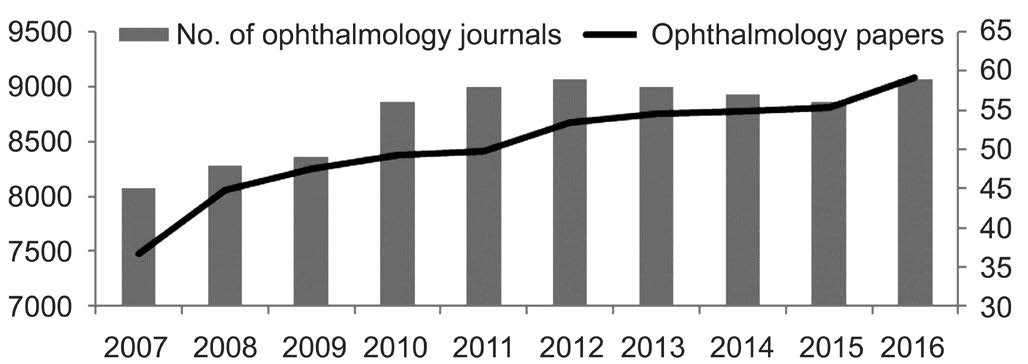
Figure 1 The number of ophthalmology journals and papers by year.
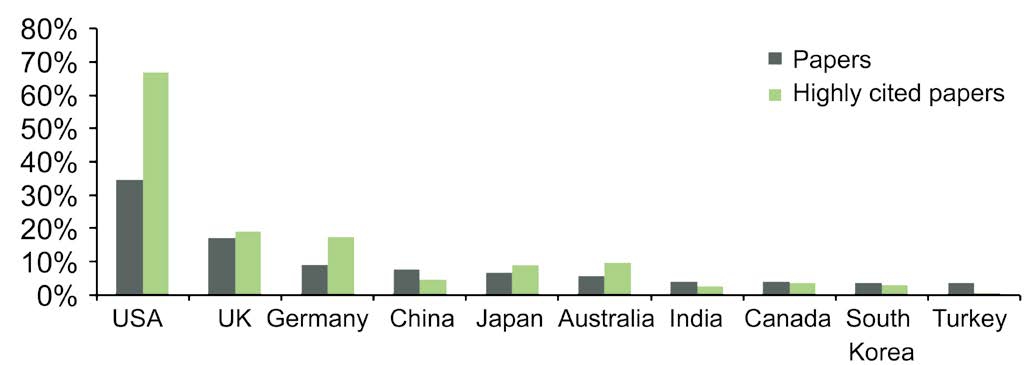
Figure 2 The distribution of ophthalmology papers and highly cited papers in Top 10 countries.
There were 3 Asian countries in Top 10 countries by the number of ophthalmology papers. They were China, Japan, and South Korea. In the development history of ophthalmology,Asian had been playing an important role. Highly cited papers distribution could reflect the impact of different countries in the field of ophthalmology. Considering the impact, only Japan broke into Top 10. Another Asian country -Singapore ranks No.10 in highly cited papers rank in countries (regions).
Table 1 showed the keywords in highly cited papers in ophthalmology by year. The Top 3 keywords in highly cited papers were “endothelial growth factor”, “optical coherence tomography” and “open-angle glaucoma”.
Regional Distribution of Ophthalmology Journals Based on the newest Journal Citation Report, there were 59 ophthalmology journals. They distributed in 13 countries. As it was showed in Table 2, ophthalmology journals in USA took up to more than half. Among the 84 681 ophthalmology papers, there were 282 highly cited papers which distribute in 30 journals. Totally 102 highly cited papers were published in Ophthalmology (USA), 30 in Progress In Retinal and Eye Research (UK). Highly cited ophthalmology papers in this two journals accounted for 46.8%.
DISCUSSION
Ophthalmology is a mature subject and it is stepping into the phase of quality jumping. The increase rate of ophthalmology papers is slower than that of world papers. The number of ophthalmology journals is stable relatively after 2010.
USA is in the leading position in ophthalmology. The ophthalmology papers in USA accounts for one thirds in the world’s ophthalmology papers. The impact of ophthalmology papers from USA is outstanding. Among the highly cited papers, the number of international collaboration countries with USA reaches to 37. We have analyzed the data and found that USA pay more attention to international collaboration. As we can see from Figure 3, USA emphasizes the collaboration in theophthalmology activities. USA has strong relationships with Germany, UK and Japan. Compared with the papers’ number,these countries has more impact in the field of ophthalmology.Only three of Asian countries (China, Japan, and South Korea)are in Top 10 by the number of ophthalmology papers. In the development history of ophthalmology, Asian countries play an important role but the influence needs to be increased.
Table 1 Main keywords in highly cited papers in ophthalmology by year
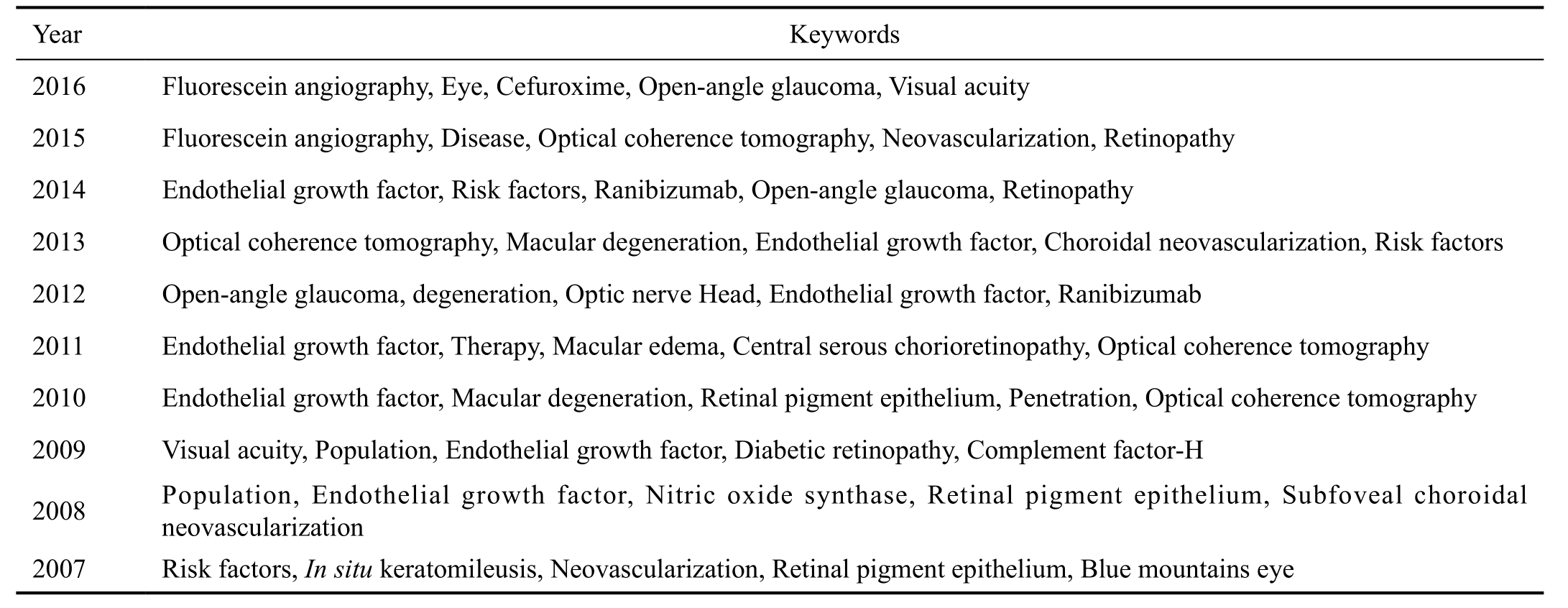
Table 2 Distribution of ophthalmology journals
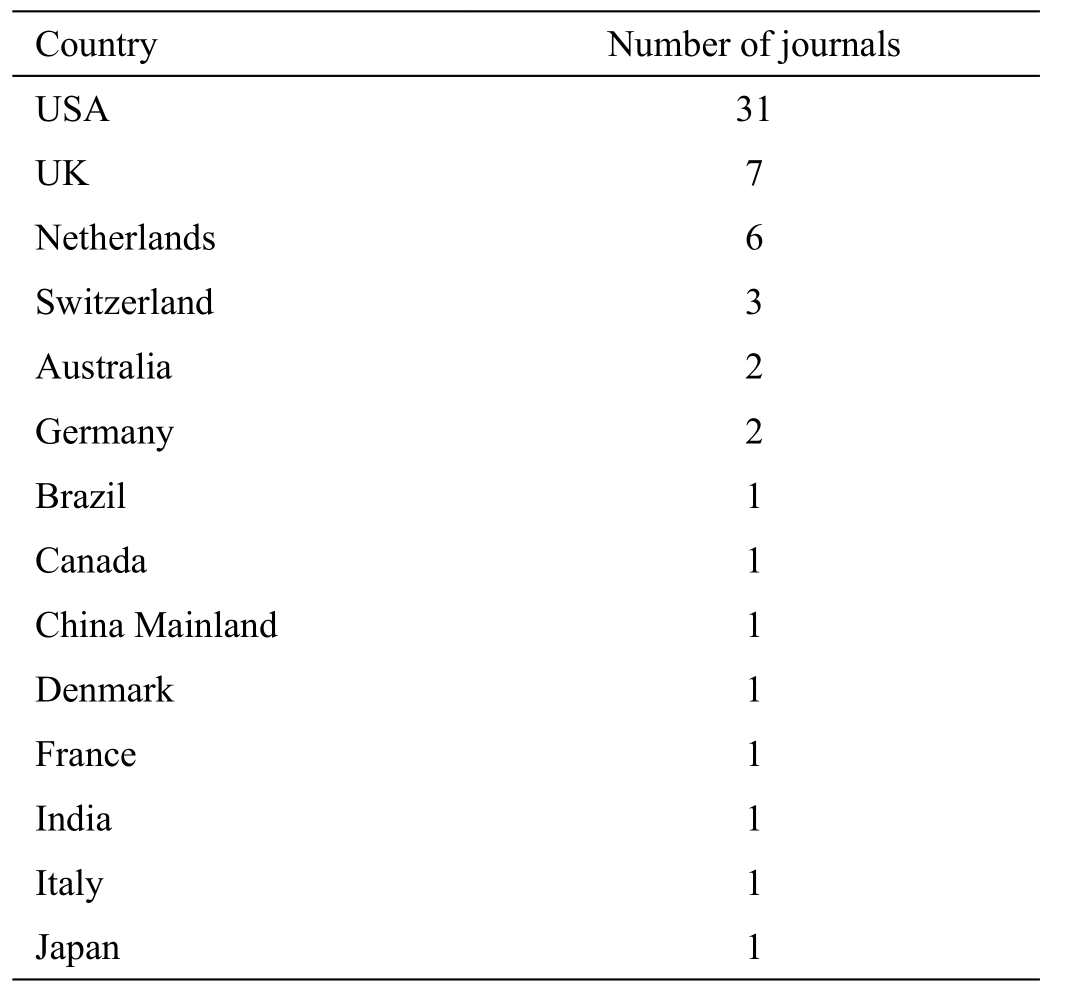
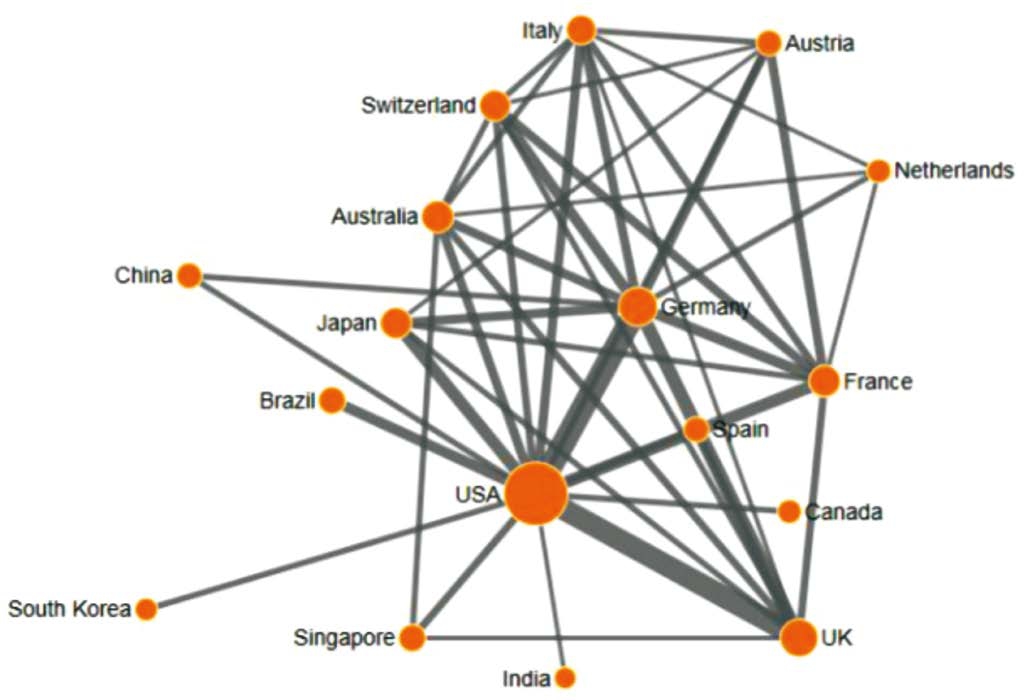
Figure 3 International collaboration relationships between countries in highly cited papers.
Leading global causes in 1990 and 2010 for blindness and for moderate to severe visual impairment were cataract,uncorrected refractive error, macular degeneration and with no change in the frequency-based ranking list from 1990 to 2010[19]. Up to now, globally, uncorrected refractive errors and un-operated cataract are still the top two causes of vision impairment[6]. The top 3 keywords in highly cited papers are “Endothelial Growth factor”, “Optical Coherence Tomography” and “Open-Angle Glaucoma”. This result shows that in recent years, more attention has been paid to the innovation of diagnosis and treatment of diseases.
China has a long history in the development of ophthalmology and contribute a lot to the world. China’s ophthalmology papers from 2007-2016 take up to 7.7% and rank in No.4.China is the 12th in the highly cited papers ranking. China has more and more impact in the field of ophthalmology, but before the quality jumping, we need more patience. Strengthen the collaboration with other countries, especially the powerful countries in the field of ophthalmology such as USA, UK,Germany and so on. Collaboration plays an important role in S&T activities with the widening of economic globalization and the relationship of collaboration exists in scientific papers[20-21].
There is only one China’s ophthalmology journal in Journal Citation Report-International Journal of Ophthalmology.Totally 59 ophthalmology journals distribute in 13 countries and USA takes up to a half. The impact of journal plays an important role in conducting highly cited papers[22]. It’s not easy to make an outstanding journal and the influence of journal is not affected by the individual papers with unusual number of citations[23]. China would have a greater impact in global ophthalmology till we had more international ophthalmology journals with high quality.
ACKNOWLEDGEMENTS
Foundations: Supported by National Social Science Foundation of China (No.15BTQ059); National Key Technology Support Program of China (No.2015BAH25F01).Conflicts of Interest: Yu ZL, None; Hu XY, None; Wang YN, None; Ma Z, None.
REFERENCES
1 Price DJD. Is technology historically independent of science? A study in statistical historiography. Technology &Culture 1965; (1):553-568.
2 Price DJD. Little science, big science. New York: Columbia University Press 1962;1-10.
3 Garfield E. Citation Indexing-Its theory and application in science,technology, and humanities. New York: ISI press 1979; 80-85.
4 Braun T. Quantitative science policy and management by using scientometrics and scientometric indicators. Scienc Foundation in China 2005;13(1): 64-72.
5 Jian G, Wang NL. Ophthalmology. Beijing: People’s Medical Publishing House 2015; 1.
6 WHO. Blindness and visual impairment prevention. Available at: http://www.who.int/blindness/ world_sight_day/2017/en/.
7 Zhao ZX, Shi XF. Progress in research of strabismus and amblyopia in China in the new century. Chinese Journal of Ophthalmology 2005;41(8):729-735.
8 Leasher JL, Bourne RR, Flaxman SR, Jonas JB, Keeffe J, Naidoo N,Pesudovs K, Price H, White RA, Wong TY, Resnikoff S, Taylor HR.Erratum. Global estimates on the number of people blind or visually impaired by diabetic retinopathy: a meta-analysis from 1990-2010.Diabetes Care 2016;39(11):1643-1649.
9 Bourne RR, Taylor HR, Flaxman SR, Keeffe J, Leasher J, Naidoo K,Pesudovs K, White RA, Wong TY, Resnikoff S, Jonas JB. Number of People blind or visually impaired by glaucoma worldwide and in world regions 1990 - 2010: a Meta-analysis. PLoS One 2016;11(10):e0162229.10 Khairallah M, Kahloun R, Bourne R, Limburg H, Flaxman SR, Jonas JB, Keeffe J, Leasher J, Naidoo K, Pesudovs K, Price H, White RA,Wong TY, Resnikoff S, Taylor HR. Number of people blind or visually impaired by cataract worldwide and in world regions, 1990 to 2010.Invest Ophthalmol Vis Sci 2015;56(11):6762-6769.
11 Bourne RR, Jonas JB, Flaxman SR, Keeffe J, Leasher J, Naidoo K,Parodi MB, Pesudovs K, Price H, White RA, Wong TY, Resnikoff S,Taylor HR; Vision Loss expert group of the global burden of disease study. Prevalence and causes of vision loss in high-income countries and in Eastern and Central Europe: 1990-2010. Br J Ophthalmol 2014;98(5):629-638.
12 Khairallah M, Kahloun R, Flaxman SR, Jonas JB, Keeffe J, Leasher J, Naidoo K, Pesudovs K, Price H, White RA, Wong TY, Resnikoff S,Taylor HR, Bourne RR; Vision Loss Expert Group. Prevalence and causes of vision loss in North Africa and the Middle East: 1990-2010. Br J Ophthalmol 2014;98(5):605-611.
13 Naidoo K, Gichuhi S, Basáñez MG, Flaxman SR, Jonas JB, Keeffe J,Leasher JL, Pesudovs K, Price H, Smith JL, Turner HC, White RA, Wong TY, Resnikoff S, Taylor HR, Bourne RR; Vision Loss Expert Group of the Global Burden of Disease Study. Prevalence and causes of vision loss in sub-Saharan Africa: 1990-2010. Br J Ophthalmol 2014;98(5):612-618.
14 Liu XL, Gai SS, Zhang SL, Wang P, Fang HL, Comparison of impact factor in different time widow. Chinese Journal of Scientific and Technical Periodicals 2014;25(12):1509-1512.
15 Gai SS, Zhang SL, Liu XL, Liu RY, Status and function of papers cited rate in the evaluation of S&T journals. Chinese Journal of Scientific and Technical Periodicals 2014;25(01):39-43.
16 Liu RY, Liu XL, Wang P, Zhang SL, Zheng CM. The rationality of foundation as a indicator in the evaluation of S&T journals. Chinese Journal of Scientific and Technical Periodicals 2013; 24(03): 472-476.
17 Fang HL, Chang HM, Liu XL. Trend and hot topic analyses if ophthalmology based on ESI data. Chinese Journal of Scientific and Technical Periodicals 2017;28(10):965-970.
18 Garfield E, Irving HS. Keywords plusTM algorithmic derivative indexing. Journal of the American society for information science 1993;44(5):298-299.
19 Jost BJ, Songhomitra PJ, Wang YX, Wei WB. Ophthalmology:potential future developments in China and worldwide. Chin Med J 2014;127(8):285-287.
20 Beaver DD, Rosen R. Studies in scientific collaboration: Part I:The professional origins of scientific co-authorship. Scientometrics 1978;1(1):65.
21 Narvaez-Berthelemot N. An index to measure the international collaboration of developing countries based on the participation of national institutions: The case of Latin America. Scientometrtics 1995;34(1):37-40.
22 Bresnahan M, Johnson A. Assessing scholarly communication and research data training needs. Reference Services Review 2013;41(3):413-433.
23 Rezaei E, Navidi I, Rokni MB, Pourmand MR. Assessing the effect of highly cited papers on the impact factor of journals in the field of public health. Iranian Journal of Public Health 2012;41(12):84-85.